Click on images to enlarge
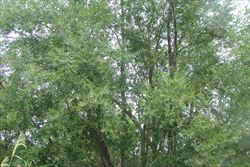
infestation (Photo: Sheldon Navie)
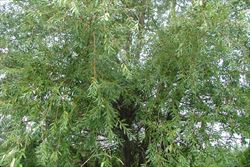
habit (Photo: Sheldon Navie)
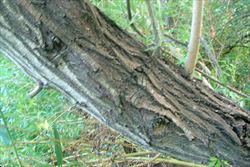
rough, deeply-fissured bark on main trunk (Photo: Sheldon Navie)
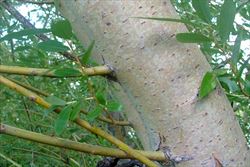
smooth bark on younger trunk (Photo: Sheldon Navie)
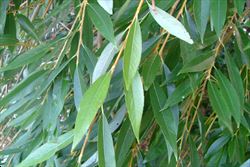
golden yellow twigs and elongated leaves (Photo: Sheldon Navie)
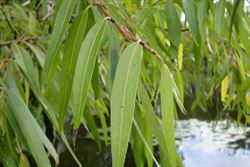
orange coloured twigs and bright green leaves (Photo: Sheldon Navie)

close-up of twigs and finely-toothed leaf margins (Photo: Sheldon Navie)

close-up of paler, hairy, undersides of younger leaves (Photo: Sheldon Navie)
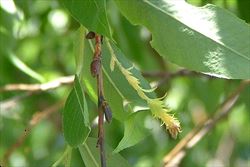
old flower cluster and brown winter buds (Photo: Sheldon Navie)
Scientific Name
Salix alba L. var. vitellina (L.) Stokes
Synonyms
Salix alba L. subsp. vitellina (L.) Arcang.Salix vitellina L.
Family
Salicaceae
Common Names
golden upright willow, golden willow
Origin
The origin of this variety is obscure, but it may have came about through the cultivation of white willow (Salix alba ) in Europe.
Cultivation
Golden willow (Salix alba var. vitellina) has been widely planted around waterbodies and along waterways in the temperate regions of Australia.
Naturalised Distribution
Naturalised in many parts of south-eastern Australia (i.e. in Victoria, Tasmania, south-eastern South Australia, the ACT and the central tablelands region of New South Wales).
Habitat
A weed of waterways, riparian vegetation, lake edges, billabongs, swamps and wetlands in wetter temperate regions.
Habit
A relatively large upright (i.e. erect) tree with one or more trunks usually growing up to 12 m tall, but occasionally reaching up to 25 m in height. It loses its leaves during winter (i.e. it is deciduous).
Distinguishing Features
-
a relatively large upright tree, with one or more trunks, that loses its leaves during winter.
-
its younger stems are hairy at first, but quickly becoming hairless, and usually take on a golden yellow or orange colour.
-
its alternately arranged leaves are elongated in shape (3-13 cm long and 0.5-2.5 cm wide) have finely toothed margins.
-
separate male and female flowers are borne on separate trees, along with the new leaves in spring.
-
both types of flowers lack any petals or sepals and are borne in elongated clusters in the upper leaf forks.
-
its small capsules (about 4 mm long) contain tiny seeds topped with a tuft of silky hairs.
Stems and Leaves
The bark on the main trunk is greyish-brown in colour and eventually becomes rough and deeply fissured. Younger branches are hairy (i.e. pubescent) at first, but quickly becoming hairless (i.e. glabrescent). They usually take on a golden yellow or orange colour and may or may not be drooping in nature (i.e. pendent).
The alternately arranged leaves are borne on short stalks (i.e. petioles) and are elongated in shape (i.e. lanceolate or narrowly-elliptic. These leaves (3-13 cm long and 0.5-2.5 cm wide) have finely toothed (i.e. serrulate) margins and pointed tips (i.e. acuminate apices). Their upper surfaces are bright green hairless, or sparsely hairy when the leaves are young (i.e. glabrescent), while their undersides are pale green, silvery or bluish-green (i.e. glaucous) and more densely hairy (i.e. pubescent).
Flowers and Fruit
Separate male and female flowers are borne on separate trees (i.e. this species is dioecious). Both types of flowers are inconspicuous and are densely arranged in elongated clusters (i.e. catkins) in the upper leaf forks (i.e. axils). They do not have any sepals or petals, but each flower is subtended by a small bract. The male (i.e. staminate) flowers are green or greenish-yellow in colour and borne in relatively short clusters (3-6 cm long and about 1 cm across). They are about 4-5 mm long and consist of two or more yellow stamens. The female (i.e. pistillate) flowers are mostly green in colour and are usually borne in longer clusters (3-9 cm long and about 6 mm across). They are about 3 mm long and consist of an ovary topped with a stigma. Flowers are produced along with the new leaves in early spring.
The fruit is a small capsule (about 4 mm long) containing tiny seeds, each of which is topped with a tuft of silky hairs.
Reproduction and Dispersal
This species reproduces by seed and vegetatively via the rooting of detached twigs or branches.
The light and fluffy seeds are easily dispersed by wind and water, while twigs and branches may be spread during floods, by machinery, during removal, and in dumped garden waste.
Environmental Impact
Golden willow (Salix alba var. vitellina) is regarded as an environmental weed in Victoria, the ACT, Tasmania and New South Wales. It is one of the willows that, as a group, are regarded as a Weed of National Significance (WoNS). These species are primarily of concern along waterways, in wetlands and around other waterbodies. They compete strongly for space, water and nutrients, eventually displacing the native vegetation in the habitats they invade.
Golden willow (Salix alba var. vitellina) also freely hybridises with related species, especially crack willow (Salix fragilis), with the resulting hybrids sometimes being even more invasive (e.g. Salix x rubens).
For more on the environmental impact of willows (Salix spp.) in Australia, see Victorian Department of Sustainability and Environment Landcare Note entitled "Willows along watercourses: their impact compared to natives", which is avialable online at http://www.dpi.vic.gov.au.
Legislation
This species is declared under legislation in the following states and territories:
- ACT: C2 - a pest plant that must be suppressed, and C4 - prohibited pest plant (a pest plant whose propagation and supply is prohibited).
- New South Wales: Class 5 - a restricted weed which must not be sold, bought or knowingly distributed (throughout the entire state).
- Northern Territory: A - to be eradicated (throughout all of the Territory) and, C - not to be introduced into the Territory.
- Queensland: Class 1 - introduction into the state is prohibited, and landowners must take reasonable steps to keep land free of this species (throughout the entire state). It is also illegal to sell a declared plant or its seed in this state.
- South Australia: 11+ - Class 11 is a category for those species that are 'Weeds of National Significance' but are not otherwise declared in South Australia. Control of this species is not currently required, but its sale is restricted throughout the state.
- Tasmania: D - the importation or sale of this species is prohibited and measures to reduce its population in an area, eradicate it from an area, or restrict it to a particular area may be required.
- Victoria: R - a restricted weed that cannot be sold or traded in this state.
- Western Australia: P1 - trade, sale or movement into the state prevented, and P2 - to be eradicated (throughout the entire state).
Management
For information on the management of this species see the following resources:
- a wide variety of resources, including the National Management Guide for Willows , is available online at http://www.weeds.org.au/WoNS/willows/.
- the Victorian Department of Sustainability and Environment Landcare Note entitled "Willows along watercourses:
managing, removing and replacing", which is available online at http://www.dse.vic.gov.au.
- the Greening Australia Willow Control fact sheet, which is available online at http://www.greeningaustralia.org.au.
Similar Species
Golden willow (Salix alba var. vitellina) is very similar to white willow (Salix alba var. alba), but they can be distinguished by the followng differences:
- golden willow (Salix alba var. vitellina) has olive green or brown coloured younger twigs and the upper surfaces of its leaves remain sparsely covered in silky hairs.
- white willow (Salix alba var. alba) has golden yellow or orange coloured younger twigs and the upper surfaces of its leaves quickly become hairless.
It is also confused with some of the other willows (Salix spp.) with tree-like habits, and hybrids between this and other species can be extremely difficult to separate from each other. To distinguish between these, see one of the texts specifically developed for the identification of willows (Salix spp.) in Australia:
- the Victorian Department of Sustainability and Environment Willow Identification Guide, which is available online at http://www.dpi.vic.gov.au.
- the Weeds of National Significance Willow Identification resource sheet, which is available online at http://www.weeds.org.au/WoNS/willows/docs/Willow_identification-Resource_Sheet2.pdf.
- the Key to Willows (Salix) in Rural Australia, which is available online at http://www.hoadley.net/cremer/willows/docs/key2.DOC.

